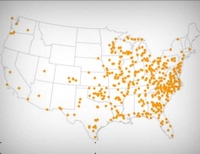Law Reviews reexamine prison gerrymandering case law
Recent Law Review pieces from Harvard and Stanford, conclude that prison gerrymandering is unconstitutional, question First Circuit's logic to the contrary
by Aleks Kajstura, June 22, 2017
A full academic year has passed since the last ruling in a case that sought to end prison gerrymandering in Cranston Rhode Island, and that time was put to good use, resulting in two recent Law Review publications.
As you may recall, in Davidson v Cranston, the District Court ruled the city’s prison gerrymandering unconstitutional, reasoning that the City could not count incarcerated people in city council districts as if they were city residents while not treating them as constituents when it came time to represent them. But the First Circuit Court of Appeals reversed the decision, allowing the City to continue using the Census’ unadjusted redistricting data despite the prison miscount.
A recent Harvard Law Review case summary by Ginger Jackson-Gleich looks at Davidson and wastes no time in dismantling the First Circuit’s reliance on Evenwel in allowing prison gerrymandering.
Recently, in Davidson v. City of Cranston, the First Circuit held that the City of Cranston, Rhode Island did not violate the Equal Protection Clause by counting prison inmates as residents of one of the City’s six wards when it redistricted. To reach this conclusion, the court relied on the Supreme Court’s decision in Evenwel v. Abbott, which approved broadly of total-population-based approaches to redistricting. While Evenwel might appear to sanction Cranston’s redistricting plan, the First Circuit’s decision is at odds with Evenwel‘s underlying reasoning and emphasis on representational equality.
This quick 8-page read provides a thorough summary and analysis of prison gerrymandering through the lens of Davidson and Evenwel.
For a much deeper dive, there is a new 66-page analysis from the Stanford Law Review, The Emerging Constitutional Law of Prison Gerrymandering, by Michael Skocpol:
This Note undertakes an in-depth analysis of one-person, one-vote challenges to prison gerrymanders and is the first scholarly work to analyze this emerging body of law. It argues that the Equal Protection Clause does limit prison gerrymandering, advocating a novel approach for adjudicating these claims—one that looks principally to community ties (or the absence thereof) between prisoners and the localities that house them. It considers the impact of the Supreme Court’s recent landmark decision in Evenwel v. Abbott and other key precedents. It also discusses relevant voting rights scholarship that courts have thus far overlooked. Ultimately, this Note aims to shed light on an underexamined constitutional right—the right to equal representation, as opposed to an equal vote—and to provide courts and litigants with the tools they need to effectively tackle prison gerrymandering claims going forward.
The second half of the Stanford piece is particularly valuable for exploring the right to equal representation as a path forward in the struggle to end prison gerrymandering.



